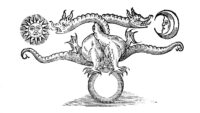Fallen leaves, yellow and brown, cover the courtyard. High in the branches, a few green stragglers hang on stubbornly. Looking up, I feel like I’m watching myself hanging on, and then suddenly, I’m watching myself watching myself. Who am I, the watcher or the watched? Am I Mini-Me or Meta-Me, or both?
All this thought, all these words; is there a meta-language that precedes it, a way of speaking that transcends speaking? For that matter, is there meta-thought, and meta-emotion? How about a meta-self, or am I just just getting tangled up in words?
Can we really say what we mean, let alone what we feel? The me that experiences the world; perhaps that’s the Meta-Me, as deep as I can go, the untouchable subjective self that’s beyond words but has no choice but to use them to communicate. Words are a second order experience, metaphor intended to convey some sense of the first-order experience of Meta-Me, the real me, not the objectified Mini-Me of name, place, and time. Ultimately, Meta-Me is indescribable, inconceivable. The best I can do is use words to point in its direction.
I’m far from the first watcher of the watched; it’s the topic of the Diamond Sūtra, (the Vajracchedikā Prajñāpāramitā Sūtra, which may be translated roughly as “The Perfection of Wisdom Text that Cuts Like a Thunderbolt”) an 800-year-old Mahayana Buddhist teaching. In it, the Buddha (The Awakened One, not to be confused with Woke) asks his devoted disciple Subhuti a series of questions, and after listening to the answers, asks them again. And again. And again. And again. And each time the Buddha asks those same questions, he ups the ante, simultaneously accepting and discarding Subhuti’s previous answers and pressing for something deeper, until finally words themselves become inadequate.
The Buddha of the Diamond Sūtra may have been the world’s first deconstructionist, the post-modern critical method used to examine the internal biases and contradictions of text and its absence of a fixed meaning. The Sūtra points not to a meta-language, but to the absence of a meta-language, and finally not just to the absence of a fixed self, but to the absence of a meta-self.
Along the way, human reality is revealed to be a reality of words, an imprecise nominal existence. As for describing the deepest reality, what we might call The Really Real, the sūtra provides no answers; it just points to words – conventional, unconventional, and profound – their non-fixed meaning, and the clouded reality they construct. The closest words get to The Really Real is the profound, which by its nature is indescribable. Ah well, so much for words. In exploring some topics, there were places even the Buddha chose not go. I, on the other hand, cannot resist.
When it comes to examining reality, moving inwards exceeds moving outwards by many orders of being. While the outer universe is immense, and with instruments such as the James Webb Telescope we can now peer deeply into its most ancient outer reaches, the inner universe is yet deeper still. Each crossing takes us further in: from the outer skin of physical self, to the life of inner organs, across the boundary of emotional feelings, probing the mental realm of thoughts, and impulse, and finally beyond the limits of matter itself into quantum realms of pure energy. Ultimately, the Meta-Me is the Meta-Verse.
Just so, just so.






Be First to Comment